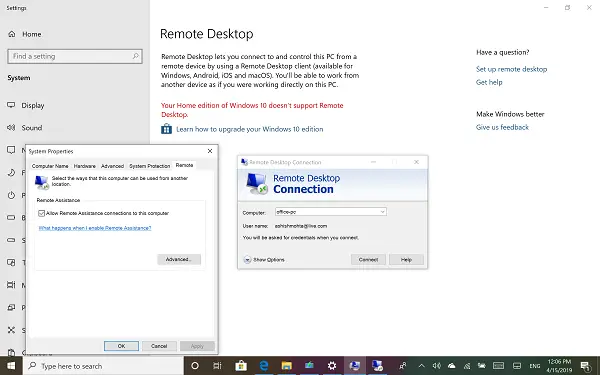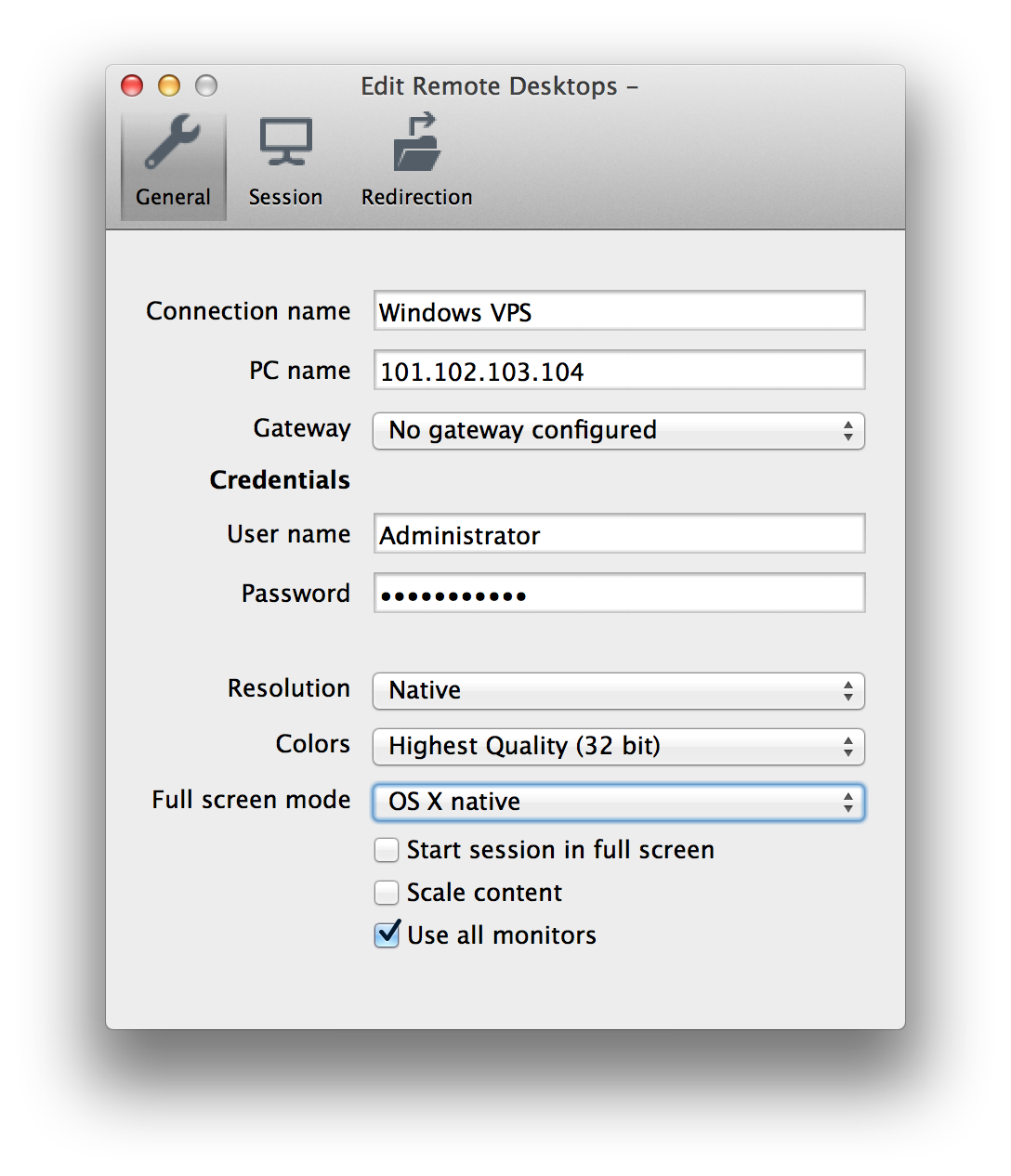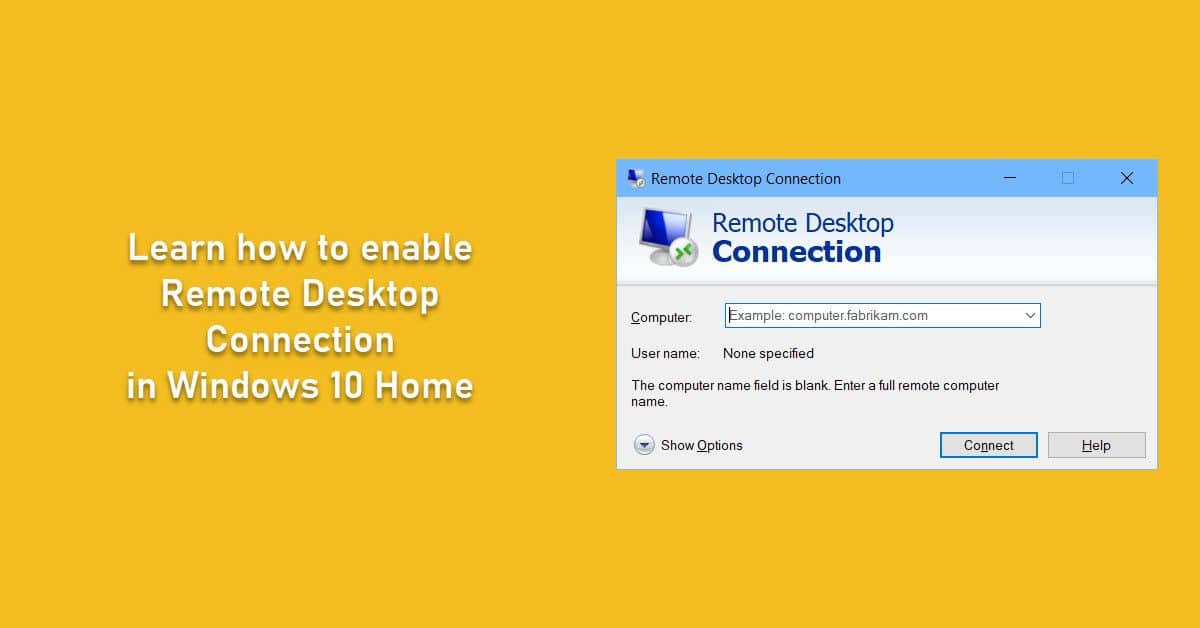Remote Utilities. Includes lots of remote access tools. Great for both spontaneous. On your local Windows 10 PC: In the search box on the taskbar, type Remote Desktop Connection, and then select Remote Desktop Connection. In Remote Desktop Connection, type the name of the PC you want to connect to (from Step 1), and then select Connect.
Since everyone started working remotely, I've personally needed to Remote Desktop into more computers lately than ever before. More this week than in the previous decade.
I wrote recently about to How to remote desktop fullscreen RDP with just SOME of your multiple monitors which is super useful if you have, say, 3 monitors, and you only want to use 2 and 3 for Remote Desktop and reserve #1 for your local machine, email, etc.
IMHO, the Remote Desktop Connection app is woefully old and kinda Windows XP-like in its style.
There is a Windows Store Remote Desktop app at https://aka.ms/urdc and even a Remote Desktop Assistant at https://aka.ms/RDSetup that can help set up older machines (earlier than Windows 10 version 1709 (I had no idea this existed!)
The Windows Store version is nicer looking and more modern, but I can't figure out how to get it to Remote into an Azure Active Directory (AzureAD) joined computer. I don't see if it's even possible with the Windows Store app. Let me know if you know how!
So, back to the old Remote Desktop Connection app. Turns out for whatever reason, you need to save the RDP file and open it in a text editor.
Add these two lines at the end (three if you want to save your username, then include the first line there)
Note that you have to use the style .AzureADemail@domain.com Putlocker the mummy 2017.
The leading .AzureAD is needed - that was the magic in front of my email for login. Then enablecredsspsupport along with authentication level 2 (settings that aren't exposed in the UI) was the final missing piece.
Add those two lines to the RDP text file and then open it with Remote Desktop Connection and you're set! Again, make sure you have the email prefix.
The Future?
Given that the client is smart enough to show an error from the remote machine that it's Azure AD enabled, IMHO this should Just Work.
More over, so should the Microsoft Store Remote Desktop client. It's beyond time for a refresh of these apps.
NOTE: Oddly there is another app called the Windows Desktop Client that does some of these things, but not others. It allows you to access machines your administrators have given you access to but doesn't allow you (a Dev or Prosumer) to connect to arbitrary machine. So it's not useful to me.
There needs to be one Ultimate Remote Windows Desktop Client that lets me connect to all flavors of Windows machines from anywhere, is smart about DPI and 4k monitors, remotes my audio optionally, and works for everything from AzureAD to old school Domains.

Between these three apps there's a Venn Diagram of functionality but there's nothing with the Union of them all. Yet.
Until then, I'm editing RDP files which is a bummer, but I'm unblocked, which is awesome.
Sponsor: Couchbase gives developers the power of SQL with the flexibility of JSON. Start using it today for free with technologies including Kubernetes, Java, .NET, JavaScript, Go, and Python.
About Scott
Scott Hanselman is a former professor, former Chief Architect in finance, now speaker, consultant, father, diabetic, and Microsoft employee. He is a failed stand-up comic, a cornrower, and a book author.
AboutNewsletter
Remote Desktop Connection, a utility included in all versions of Windows 10, allows you to use a laptop or home computer to remotely control the Windows-based desktop computer in your on-campus office or lab. When using Remote Desktop Connection from a laptop on a wireless network (including Purdue's AirLink network and free public WiFi networks in coffee shops, hotels, etc.) or a home computer on a broadband Internet connection, it's as if you're sitting at the desk in your office using your computer's keyboard and mouse -- even if you're two buildings, two miles, or two continents away.
By remotely accessing an ECN-supported desktop computer and refraining from storing your Purdue files locally on your laptop or home computer, your data remains safely stored in your home directory on ECN's network servers -- which receive daily backups.
- If you're using Windows 7 rather than Windows 10, please see Remote Desktop Connection in Windows 7 instead.
- If you have a Macintosh desktop at home or a Mac laptop but have a Windows-based desktop computer in your office, Microsoft also provides a free Mac version of Remote Desktop Connection; please see Remote Desktop Connection in Mac OS X.
You'll want to follow these instructions on your laptop and/or home computer, not on the on-campus desktop computer!
When connecting from off-campus, please don't miss step #6! Connecting first to Purdue's Virtual Private Network is required.
VPN instructions for Windows: http://eng.purdue.edu/jump/2e76c72
Who can use Remote Desktop Connection? Chapter 16: return to roots.
A remote-controlled computer can be used by only one person at a time. As such, it is recommended for use only by those who do not share the same office computer with other people. A graduate student may use Remote Desktop Connection with the permission of their supervisor.
Every office computer which will be used remotely must be pre-configured by ECN before this service will work. Please contact us in advance; we will provide you with the value that you'll need in step #2A.
Creating a Remote Desktop shortcut
Download Microsoft Remote Desktop 10
1. Opening the Remote Desktop Connection program on your Windows 10-based computer
1A. To open the program, press and hold the Windows key (between 'Ctrl' and 'Alt' keys), and simultaneously press the 'R' key. This should bring up a box that says 'Run'. Release the Windows key. (This can be called 'pressing Win+R').
1B. Type in 'mstsc' and press your Enter key or the 'OK' button.
2. Computer address.
2A. In the 'Computer' field, enter the IP number of the desktop computer in your office. It will look similar to one of the following:
10.165.xxx.yyy
arms1234pc01.ecn.purdue.edu
You may either skip to step #6 (to connect to the remote computer immediately) or proceed with step #2B (to set program options and create a shortcut for future use).
2B. Then click on the 'Options' button. The window will expand to show several tabs, each with various program settings.
3. The 'Experience' tab.
This step is optional. These settings might help improve your remote connection's performance.
3A. Click on the 'Experience' tab.
3B. Click the menu beneath 'Choose your connection speed to optimize performance' and select one of the following:
- For most public WiFi services or home DSL connections, try 'Low-speed broadband (256 Kbps - 2 Mbps)'.
- For home cable modem connections, try 'High-speed broadband (2 Mbps - 10 Mbps)'.
4. The 'General' tab.
4A. In the 'User name' field, type your Purdue Career Account username.
Leave the 'Allow me to save credentials' box unchecked.
4B. Click on the 'Save As' button to proceed to the next step. The 'Save As' dialog will appear.
5. Saving your shortcut file.

In this step, you'll create a shortcut file which you will later begin using routinely to launch a remote control session to your office PC. You may save this shortcut wherever you prefer; we suggest saving a copy to your desktop.
5A. In the 'Save As' dialog, click on the 'Desktop' icon in the left-hand column. This will set the 'Save in' location to the desktop.
5B. In the 'File name' field, type a name that you'll recognize. We suggest something like the following:
If you'll be creating shortcuts to multiple remote computers (say, one for each person who uses a shared home computer, each pointing to their unique office PC), you could enter a more specific name, e.g.:
5C. Click the 'Save' button.
The new shortcut file will be created on the desktop.
5D. (This step is optional.) If you'd like the shortcut to appear in more places, this would be a good time to make copies of it. You could drag the icon from the desktop to the Start button, for example, to place a copy of the shortcut in your Start menu.
Connecting to the desktop computer in your office
These instructions assume that your computer is connected to the Internet, either wirelessly or via a broadband connection (e.g. cable modem or DSL).
6. Connect to Purdue's Virtual Private Network. When using a computer off-campus, this step is required. Establish a connection to Purdue's Virtual Private Network (https://webvpn.purdue.edu). For a description of this service, please see ITaP's VPN 'Getting Started' page. K3g full movie, online, free. ITaP also has a guide to using Cisco AnyConnect. As a last resort, you can use the built-in L2TP VPN built into Windows.
7. Start the remote connection. If you saved the icon to the desktop in step #5, locate it there and double-click the icon now.
Alternately, repeat steps #1 and #2A, and then click the 'Connect' button.
:max_bytes(150000):strip_icc()/RemoteDesktopMac-5c90020ec9e77c0001e11dd7.jpg)
Your laptop or home computer will connect via the Internet to your desktop computer in your office.
8. Remote computer verification.
You might see a dialog (like the one shown at right) noting that the remote computer's identity cannot be verified.
8A. You may optionally enable (place a check mark in) the 'Don't ask me again for connections to this computer' box. When the password prompt appears, enter your Purdue Career Account password.
8B. Then click the 'Yes' button.
Remote Desktop 10 Windows
9. Password prompt.
A password prompt will appear. Because you are connecting to an ECN-supported PC which is a member of an Active Directory domain, you might need to do a couple extra steps.
The login prompt may look like the one on the left in the illustration, below:
9A. If the dialog appears as above, click the 'Use another account' button.
9B. Enter your username as follows, substituting your own Purdue Career Account username:
NOTE: if your computer has not been migrated to Windows 10 you should use ecnusername
9C. Enter your Purdue Career Account password.
9D. Then click the 'OK' button.
Your office computer's desktop will appear. If you had left programs running and/or files open on your office computer, they'll appear now, just as they were. If you had logged out of Windows before you left your office, your ECN-supported office computer will go through the typical startup process, finishing with the Message of the Day window -- just as when you're in the office.

Now, while your remote connection is open, when you type or use your mouse, it'll be like using the keyboard and mouse at your office computer.
Minimizing and/or disconnecting
10. Using the top-central tool bar.
While connected to the remote computer, a toolbar appears at the top of your screen like the one shown here:

10A. If you need to access a file or program on your local computer (the laptop or home computer you're using), click the minimize button on the top-central tool bar. Remote Desktop Connection will stay running (as will all programs you have open on your office PC); restore it by clicking its button on the task bar (at the bottom of your screen, usually).
10B. When you're ready to disconnect from your office PC, you may end the session one of these ways:
- Click on the 'X' button at the right edge of the top-central toolbar. This will end the remote session but leave files and programs open and running on your office PC.
- Or, as shown in the illustration below, click on the (remote computer's) Start menu and select 'Log off.' This will close all open files and programs on your office PC and also end the remote session.
Remote Desktop 10.2.13
Last modified: 2020/08/19 09:12:29.340018 GMT-4 by sundeep.rao.1
Created: 2018/03/08 11:20:13.266833 US/Eastern by oesten.e.nelson.1.
Categories
- Knowledge Base > OS > Windows > Windows 10
- Knowledge Base > ECN > RDP
- Knowledge Base > Software > RemoteDesktop
Search
Type in a few keywords describing what information you are looking for in the text box below.
